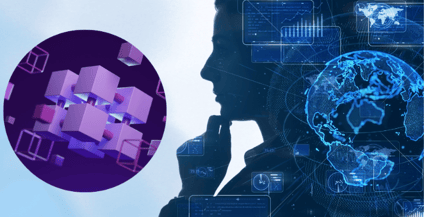Digital Foundation for Intelligent Infrastructure Part I New Economy Brain
Intelligent Infrastructure and the Coming Transformation
Intelligent infrastructure refers to the integration of advanced technologies, data analytics, and connectivity into traditional physical infrastructure systems in our communities, cities, states and countries.
- Autonomy Institute, Intelligent Economic Zones
Intelligent Infrastructure integrates advanced technologies and data driven solutions into the physical infrastructure of the build environment to improve efficiency, sustainability and overall quality of life for a nation's citizens and the collective good.
The goal is to enhance the functionality and management of public services such as transportation, utilities, public safety, healthcare, education, and more, through visionary and strategic use of the latest technologies.
 It is said, and hoped, that the so-called fourth Industrial Revolution, Industry 4.0, will unleash an unprecedented productivity boom that will transform everything.
It is said, and hoped, that the so-called fourth Industrial Revolution, Industry 4.0, will unleash an unprecedented productivity boom that will transform everything.
Similar to the revival during the Rural Electrification Act of 1936 at the height of the Great Depression, and the Interstate Highway acts in 1956 during post-World War II economic growth and transformation.
A new national revival is needed, it is argued, to address new and current national challenges, not only building infrastructure, but
...providing advanced city services, resilient and carbon-free economies, closing the technology divide, enabling autonomous systems, and most important: securing data for people, cities and governments. Creating millions of new jobs and economic growth nationwide.” (ibid)
The Brains of the New Economy
Intelligent Infrastructure, notes Norm Anderson, "will be the brains of our economy." Extending this analogy of the brain, it might be safe to say that the brain, broadly, does three things:
- Analysis and Inference: The brain analyses its past, its known and unknown collective experiences, clues and evidence, and then, based on that data, makes inferences about the the world around it, and decisions on action.
- Predictions and Decisions: The brain takes those inferences to make predictions. Or, more correctly, what are the probabilities of predictions being true at an acceptable level of confidence.
- Actions and Analysis (again): Having built theories based on inferences, the brain then utilizes the tools and technologies at hand, to make decisions, take action and then evaluate the value and success of those decisions.

- There is a system that interoperates to collect and evaluate data and information.
- That data is processed, using rules learned over time, to make predictions of what what will happen.
- Competing predictions are evaluated, and a decision (judgement) is made to take action, which is then evaluated as another data point to make more inferences and predictions.
Powering Intelligent Infrastructure from Cloud to Edge
- Cloud - a system of interoperable and scalable resources consisting of compute, storage, and networking. The cloud, and power to the cloud, acts as an utility providing the fabric that powers, stores and connects, and scales up and down easily.
- HUB - Nodes in the network where activity happens with greater concentration and levels of computational power, access to data and data models, processing, storing, analyzing, etc.
- The Edge - Because of the need for concentrated power at Hubs, they are by definition distant from the data it wants to analyse. Data is captured where it is produced, at the edge, through the use of edge computing devices across locations.
Data is generated locally, in place. That place is often referred to as the Edge. The Edge is where data is created. As it is closer in proximity to the the genesis of that data (traffic, production, points of sale, etc), the edge is better able to capture the data faster, and, in many instances, more accurately, through the use of sensors, and other interconnected things.
But the problem with the Edge is that it doesn’t have the compute power to properly understand the impact of the data - it is more difficult to run large scale inferences at the Edge.
This is the dilemma that well architected Intelligent Infrastructure has to address - the balance between proximity to data, bandwidth, power and relative costs.
End Part I
Part II: Orchestrating the Brains of the New Economy from Hub to Edge AI
Related:
Smart City Solutions from HCL on Supermicro and Intel Edge Infrastructure


